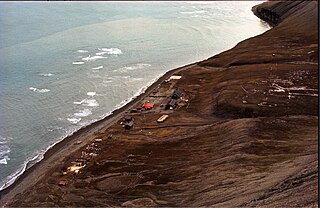Kjerulføya is an island north of Nordaustlandet in Svalbard, Norway. It is named for Theodor Kjerulf. [1] The island is located within Nordaust-Svalbard Nature Reserve.

Nordaustlandet is the second-largest island in the archipelago of Svalbard, Norway, with an area of 14,443 square kilometres (5,576 sq mi). It lies north east of Spitsbergen, separated by Hinlopen Strait. Much of Nordaustlandet lies under large ice caps, mainly Austfonna and Vestfonna, the remaining parts of the north being tundra inhabited by reindeer and walruses. The island is uninhabited and lies entirely within Nordaust-Svalbard Nature Reserve.

Svalbard is a Norwegian archipelago in the Arctic Ocean. Situated north of mainland Europe, it is about midway between continental Norway and the North Pole. The islands of the group range from 74° to 81° north latitude, and from 10° to 35° east longitude. The largest island is Spitsbergen, followed by Nordaustlandet and Edgeøya. Administratively, the archipelago is not part of any Norwegian county, but forms an unincorporated area administered by a governor appointed by the Norwegian government. Since 2002, Svalbard's main settlement, Longyearbyen, has had an elected local government, somewhat similar to mainland municipalities. Other settlements include the Russian mining community of Barentsburg, the research station of Ny-Ålesund, and the mining outpost of Sveagruva. Ny-Ålesund is the northernmost settlement in the world with a permanent civilian population. Other settlements are farther north, but are populated only by rotating groups of researchers.

Norway, officially the Kingdom of Norway, is a Nordic country in Northern Europe whose territory comprises the western and northernmost portion of the Scandinavian Peninsula; the remote island of Jan Mayen and the archipelago of Svalbard are also part of the Kingdom of Norway. The Antarctic Peter I Island and the sub-Antarctic Bouvet Island are dependent territories and thus not considered part of the kingdom. Norway also lays claim to a section of Antarctica known as Queen Maud Land.
In the film Orion's Belt, Kjerulfsøya is the location of the Soviet bearing station. [2]

Orion's Belt is a 1985 Norwegian dual-language, political action thriller film, directed by Ola Solum and Tristan DeVere Cole. It is based on Jon Michelet's 1977 novel by the same name. The film follows three Svalbard-based shabby seamen, played by Helge Jordal, Sverre Anker Ousdal and Hans Ola Sørlie, who discover a Soviet bearing station. They are subsequently targets of Soviet liquidation and American interrogation in an attempt to quiet them and retain the political status quo. The Cold War topics were a critique of the Norwegian policy of allowing a Soviet presence on Svalbard.




